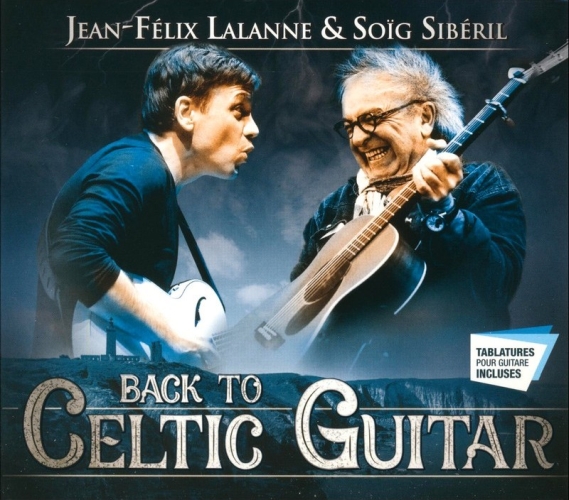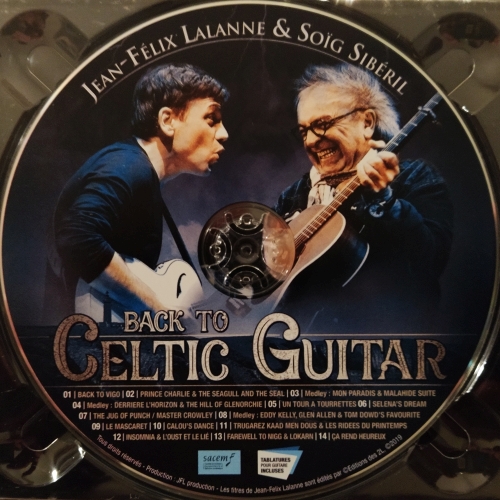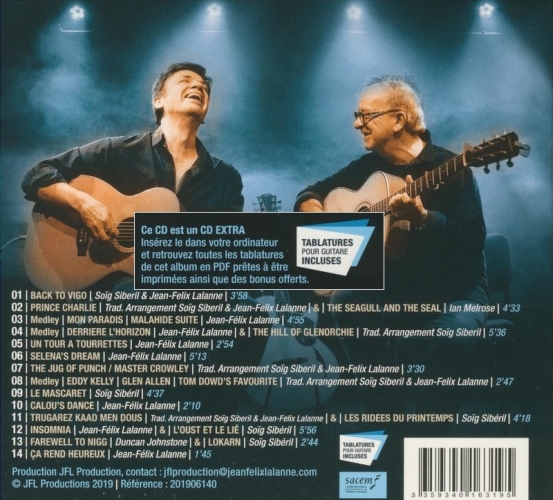Jean-Félix Lalanne
& Soig Siberil, Back
to Celtic Guitar,
CD Coop Breizh 2019 - CD4016319
Après "La renaissance de la harpe celtique" d'Alan Stivell,
on peut parler, après de nombreuses années, d'un
autre "retour": celui que Soïg Siberil et
Jean-Félix Lalanne ont fait en 2019. Mais il ne s'agit pas
de harpe mais de guitare, deux guitares pour être
précis, qui ont trouvé un lien symbiotique fort
au fil des ans. En fait, nous ne sommes pas en présence de
la première collaboration entre ces deux artistes car,
déjà en 2010, ils avaient travaillé
ensemble pour le projet "Autour de la guitare celtique" avec trois
autres guitaristes (Dan Ar Braz, Gilles Le Bigot and Gildas Arzel). Le
concept de "retour" est ici très significatif car
Soïg et Jean-Félix réinventent de
nouvelles techniques et donnent un nouveau sens au rôle de la
guitare dans la musique dite "celtique". Le maître Patrice
Marzin participe en tant qu’auteur de l'enregistrement, du
mixage, mais aussi d'arrangements nombreux et innovants. Le CD comprend
également les tablatures pour guitare et utilise les
photographies d'Eric Legret et de Myriam Jegat dans le cadre d'un
concept graphique conçu par Sylvain Adamik. "Back to Vigo"
est une composition dédiée à la Galice
et à la ville de Vigo en particulier. Jean-Félix
utilise une guitare acoustique Martin et une guitare-synthé
Lag Signature avec sortie MIDI: cet instrument est plus un clavier
qu'une guitare car il produit un son synthétisé
en sortie. Soïg utilise une guitare acoustique Boucher. La
programmation de Patrice Marzin intervient sur le rythme pour rendre le
morceau très suggestif et innovant. "Prince Charlie" est un
thème écossais traditionnel riche en veines
baroques, arrangé par Soïg sur la base de
l'interprétation de Ian Melrose, musicien avec qui il a
précédemment collaboré au projet
"Celtic guitar Journeys" ; il est suivi de " The Seagull And The Seal "
de Ian Melrose, version écossaise de "La cigale et la
fourmi" ("The Ant and the Grasshopper"). Suit le medley
composé de "Mon Paradis" de Jean-Félix , relatif
à la période pendant laquelle l'artiste a
vécu en France, et de "Malahide suite", arrangé
par Soïg avec la technique du "tapping" consistant
à battre les cordes avec la main droite afin d'obtenir un
effet rythmique surprenant. Le quatrième morceau de l'album
est un autre medley qui commence par "Derrière l'horizon",
une composition que Jean-Félix dédie au coucher
de soleil sur les plages de Malahide, une ville du comté de
Fingal, suivi de "The Hill Of Glenorchie" une chanson traditionnelle,
arrangée par Soïg avec la guitare-synthé
de Jean-Félix qui vient à merveille enrichir le
morceau de nuances blues. "Un tour à Tourrettes" est une
composition de Jean-Félix dédiée
à un lieu considéré comme
idéal pour vivre: le village de Tourrettes-sur-Loup; ici,
les harmoniques finales sont vraiment charmantes. "Selena’s
Dream" est aussi une composition de Jean-Félix,
structurée en trois mouvements et
dédiée à sa nièce
désormais adulte. Ensuite, nous trouvons deux reels
irlandais The Jung of Punch / Master Crowley arrangés par
les deux musiciens : le premier est plus doux en rythme et presque
baroque: ici, Jean-Felix laisse sa guitare Martin pour jouer sur une
Takamine. Le huitième morceau comprend trois reels irlandais
“Eddy Kelly, Glen Allen, Tom Dowd’s
Favourite” qui, d’habitude, sont joués
au violon; dans cette version, la transcription pour les guitares est
pour le moins surprenante. Puis nous trouvons "Le Mascaret",
composition de Soïg dont le « delay »
rythmique, ainsi que la guitare-synthé de
jean-Félix et les percussions programmées par
Patrice Marzin, rendent le morceau vraiment admirable.
"Calou’s dance" est une composition hautement
inspirée et techniquement élégante de
Jean-Félix, dédiée à sa
compagne Caroline. Suit un medley arrangé par les deux
guitaristes, introduit par une mélodie vannetaise Trugarez
Kaad Men Dous (à l’origine une chanson Merci Ma
Bien Aimée) et poursuivi par deux Laridés Les
Ridées du Printemps, soit deux danses en chaine à
six temps. Puis deux compositions liées entre elles: la
première est "Insomnia" de Jean-Félix suivie de
deux Ronds de Loudéac L’Oust Et Le Lié,
dont le dernier est enrichi par les effets rythmiques des percussions
programmées par Patrice Marzin. Nous nous dirigeons vers la
conclusion de l'album avec un autre medley: tout d'abord une marche
écossaise Farewell To Nigg de Duncan Johnstone, bien connue
et souvent jouée par de nombreux groupes, suivie de "Lokarn"
de Soïg. Ici, Jean-Félix utilise sa Takamine. La
conclusion est un morceau très amusant Ça rend
Heureux: Jean-Félix joue du ukulélé
électrifié pendant que Soïg effectue un
tapping hawaïen.
After Alan Stivell's “Renaissance
de la harpe celtique” (i.e. "Rebirth of the Celtic Harp") we
can talk, after many years, of another "return": what Soïg
Siberil and Jean-Félix Lalanne made during 2019. But this
the topic is not about the harp but the guitar, two guitars to be
precise, which have found a strong symbiotic link over the years. In
fact, we are not facing the first collaboration between these two
artists because, already in 2010, they had worked together in the
project "Autour de la guitare celtique" with three other guitarists
(Dan Ar Braz, Gilles Le Bigot and Gildas Arzel). The concept of
"return" is very significant here because Soïg and
Jean-Félix reinvent new techniques and give a new meaning to
the role of the guitar within the so-called "Celtic" music. The Maestro
Patrice Marzin is involved as author of the recording, of the mix but
also of numerous and innovative arrangements. The CD also includes
guitar tablatures and uses Eric Legret's and Myriam Jegat’s
photographs in the framework of a graphic concept conceived by Sylvain
Adamik. "Back to Vigo" is a composition dedicated to Galicia and to the
city of Vigo in particular. Jean-Félix uses a Martin
acoustic guitar and a Lag signature guitar-synth with MIDI output: in
fact, that instrument is more a keyboard than a guitar because it
produces a synthesized sound at the output. Soïg plays a
Boucher acoustic guitar. Patrice Marzin's programming intervenes on the
rhythm to make the piece highly suggestive and innovative. "Prince
Charlie" is a traditional Scottish theme rich in baroque veins,
arranged by Soïg based on the interpretation of Ian Melrose, a
musician with whom he has already collaborated in the "Celtic guitar
journeys" project. The second piece "The seagull and the seal" by Ian
Melrose is a Scottish version of "The cicada and the ant" (in French
“La cigale et la fourmi”). Follows the medley of
Jean-Félix's "Mon Paradis" (i.e. “My
paradise”), relating to the period in which the artist lived
in France, and of "Malahide suite", arranged by Soïg with the
"tapping" technique which consists in beating the strings with the
right hand to obtain a surprising rhythmic effect. The fourth piece of
the album is another medley opened by "Derrière l'horizon"
(i.e. “Below the horizon”), a composition that
Jean-Félix dedicates at sunset on the beaches of Malahide, a
town in the county of Fingal, followed by a traditional song
“The Hills od Glenorchie”, arranged by
Soïg with the guitar-synth by Jean-Félix who comes
in wonderfully, enriching the piece with bluesy nuance. "Un tour
à Tourrettes" is a composition by Jean-Félix
dedicated to a place considered ideal for living: the village of
Tourrettes-sur-Loup; enchanting in this case is the round of harmonics.
"Selena's dream" is still a composition by Jean-Félix,
structured in three movements and dedicated to her granddaughter now
grown up. So, we come to two Irish reels The Jung of Punch / Master
Crowley arranged by the two musicians, the first of which is slower in
rhythm and almost baroque in taste: Jean-Felix leaves his Martin guitar
here to take a Takamine. The eighth composition of the album still
consists of three Irish reels “Eddy Kelly, Glen Allen, Tom
Dowd’s Favourite” generally performed on the
violin; in this version however, the transcription for guitars is at
least surprising. Following we find "Le Mascaret", the composition is
by Soïg whose rhythmic delay, together with the guitar-synth
by Jean-Félix and the percussions programmed by Patrice
Marzin, make the piece truly admirable. "Calou’s dance" is a
highly inspired and technically elegant composition by
Jean-Félix, dedicated to her partner Caroline. A medley
arranged by both guitarists follows, introduced by a melody
“Trugarez Kaad Men Dous” from the Vannes region
(originally a song “Merci ma bien aimée”
i.e. “Thank you my beloved”) and consisting of two
Laridé “Les Ridées du
Printemps”, two dances chained in six tempos. Then are
proposed two compositions related to each other: the first is
"Insomnia" by Jean-Félix followed by two Ronde de Loudeac
“L’oust et Le Lié” by
Soïg, the last of which is enriched by the rhythmic effects of
the percussion programmed by Patrice Marzin. We are moving towards the
conclusion of the album with another medley: first a Scottish march
“Farewell to Nigg” by Duncan Johnstone, well known
and already performed by various groups, followed by Soïg 's
"Lokarn". Here Jean-Félix plays his Takamine. The conclusion
is entrusted to a very amusing piece “Ça rend
heureux” (i.e. “It makes Happy”), with
Jean-Félix on the electrified ukulele and Soïg
performing a Hawaiian tapping.
Dopo la “Rinascita
dell’arpa celtica” di Alan Stivell possiamo
parlare, a tanti anni di distanza, di un altro
“ritorno”: quello che Soïg Siberil e
Jean-Félix Lalanne hanno confezionato nel corso del 2019. Ma
non si tratta qui di arpa ma di chitarra, di due chitarre per la
precisione, che hanno trovato negli anni un forte legame simbiotico.
Non siamo infatti di fronte alla prima collaborazione tra questi due
artisti perché, già nel 2010, essi avevano
lavorato assieme nel progetto “Autour de la guitare
celtique”. Il concetto di “ritorno”
è qui molto significativo perché Soïg e
Jean-Félix reinventano nuove tecniche e danno nuovo
significato al ruolo della chitarra all’interno della musica
cosiddetta “celtica”. Di mezzo, ci si mette inoltre
il maestro Patrice Marzin, autore della registrazione, del mix, ma
anche di numerosi e innovativi arrangiamenti. Il CD include inoltre le
tablature per chitarra e si avvale delle fotografie di Eric Legret nel
quadro di una concezione grafica ideata da Sylvain Adamik.
“Back to Vigo” è una composizione
dedicata alla Galizia e alla città di Vigo in particolare.
Jean-Félix utilizza una chitarra-synt dotata di uscita MIDI:
di fatto è più una tastiera che una chitarra
perché in uscita produce un suono sintetizzato. Sulla
ritmica interviene poi la programmazione di Patrice Marzin a rendere il
pezzo fortemente suggestivo e innovativo. “Prince
Charlie” è un tema tradizionale scozzese ricco di
venature barocche, arrangiato da Soïg sulla base
dell’interpretazione di Ian Melrose, musicista col quale ha
già collaborato nell’ambito del progetto
“Celtic guitar journeys”. Il secondo pezzo
“La foca e il gabbiano” è un adattamento
del tradizionale scozzese “La cicala e la formica”.
Segue il medley di Jean-Félix “Mon
Paradis”, relativo al periodo in cui l’artista ha
vissuto in Francia, e “Malahide suite”, arrangiato
da Soïg con la tecnica del “tapping” che
consiste nel battere le corde son la mano destra in modo da ottenere un
effetto ritmico sorprendente. Il quarto pezzo dell’album
è un altro medley aperto da “Derrière
l’horizon”, composizione che Jean-Félix
dedica al tramonto sulle spiagge di Malahide, località nella
contea del Fingal, seguito da un brano tradizionale, arrangiato da
Soïg con la chitarra-synt di Jean-Félix che entra
meravigliosamente, arricchendo il pezzo di sfumature blues.
“Un tour à Tourrettes” è una
composizione di Jean-Félix dedicata a un luogo considerato
ideale per vivere: il villaggio di Tourrettes-sur-Loup; incantevole in
questo caso è il giro di armonici conclusivo.
“Selena’s dream” è ancora una
composizione di Jean-Félix, strutturata in tre movimenti e
dedicata alla sua nipotina ormai diventata adulta. Arriviamo
così a due reels irlandesi arrangiati dai due musicisti, il
primo dei quali è di ritmo più lento e di gusto
quasi barocco: Jean-Felix lascia qui la sua chitarra Martin per
imbracciare una Takamine. L’ottava composizione
dell’album è ancora costituita da due reels
irlandesi che, di norma, vengono eseguiti al violino; in questo caso
tuttavia la trascrizione per chitarre è quantomeno
sorprendente. A seguire troviamo “Le Mascaret”, la
composizione è di Soïg il cui ritmico delay,
unitamente alla chitarra-synt e alle percussioni programmate da Marzin,
rendono il pezzo davvero mirabile. “Calou’s
dance” è una composizione di Jean-Félix
molto ispirata e tecnicamente elegante, dedicata alla compagna
Caroline. Segue un medley arrangiato da entrambi i chitarristi,
introdotto da una melodia proveniente dalla regione di Vannes e
costituito da due Laridé, vale a dire da due danze
incatenate in sei tempi. Poi due composizioni tra loro legate: la prima
è “Insomnia” di Jean-Félix
seguita da due “Ronde” de Loudeac,
l’ultima delle quali si arricchisce degli effetti ritmici
delle percussioni programmate da Patrice Marzin. Ci si avvia verso la
conclusione dell’album con un altro medley: prima una marcia
scozzese di Duncan Johnstone, assai nota e già eseguita da
vari gruppi, seguita da “Lokarn” di Soïg.
Qui Jean-Félix rispolvera la sua Takamine. La conclusione
è affidata a un pezzo assai divertente, con
Jean-Félix all’ukulele elettrificato e
Soïg che si esibisce in un tapping hawaiano.
Tracks :
01 | BACK TO VIGO - 02 | PRINCE CHARLIE & THE SEAGULL AND THE
SEAL - 03 | Medley : MON PARADIS - MALAHIDE SUITE - 04 | Medley :
DERRIERE L’HORIZON & THE HILL OF GLENORCHIE - 05 | UN
TOUR A TOURRETTES - 06 | SELENA’S DREAM - 07 | THE JUG OF
PUNCH - MASTER CROWLEY - 08 | Medley : EDDY KELLY - GLEN ALLEN - TOM
DOWD’S FAVOURITE - 09 | LE MASCARET - 10 | CALOU’S
DANCE - 11 | TRUGAREZ KAAD MEN DOUS & LES RIDEES DU PRINTEMPS -
12 | INSOMNIA & L’OUST ET LE LIÉ - 13 |
FAREWELL TO NIGG & LOKARN - 14 | ÇA REND HEUREUX
|


